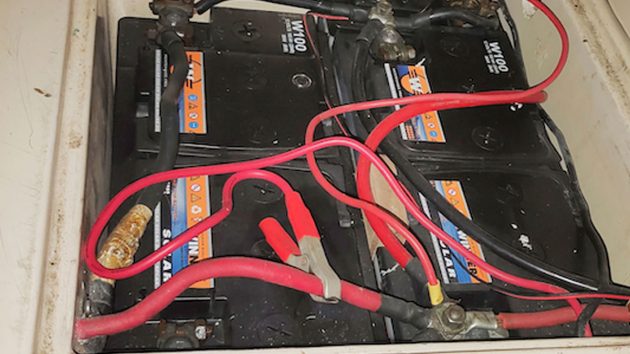Engineering guru Vyv Cox confesses to a less-than impressive track record of winterizing boat batteries – but shares his new-found solution
Winterizing boat batteries: an expert guide
For almost 20 years Jill and I have been summer liveaboards, cruising the Mediterranean, mostly Greece, for half the year.
The only exceptions to this have been that in 2012 we only managed six weeks on Leros at the end of the season due to an injury at home, we missed 2017 altogether due to my radiotherapy for prostate cancer and we lost 2020, 2021 and much of 2022 due to Covid.
Our over-wintering procedure has become very thorough over this time, with the result that our Sadler 34 has survived in excellent condition.
Our history with batteries, though, is not so impressive but we may at last have found the solution.
Past methods for winterizing boat batteries
In the Sadler the three batteries sit in a moulded box next to the engine room, limiting modification options somewhat.
As bought, two of these were domestic and one was the starter, all of 110Ah capacity.
Running our boat fridge 24/7, the morning voltage was often down to 12.0 and we realised that adding a domestic battery would improve this considerably.
We did this in 2009 by changing the starter battery to a Red Flash 1100 located next to the gearbox in the engine room and using the ex-starter battery as number three in the domestic bank.

Red Flash 1100 AGM battery alongside the gearbox in the engine room. Credit: Vyv Cox
This setup lasted until 2011, when we replaced them with 3 x Bosch S5103 100Ah closed cell type.
Left charging by our 125W solar panels via a Sunworks PWM controller they had failed on our return to the boat in spring 2015.
These were replaced by locally bought Modile 120Ah leisure-type batteries, initially not holding charge well but settled after a few days.
During our enforced absence of 2017 a friend covered the bigger of our two panels, leaving only 40W of charge, but the bank had totally failed by May 2018, with plates exposed due to loss of the electrolyte.
Once again we paid up for three new batteries, this time Winner Solar W100 (100Ah) open cell lead acid, sourced in Athens and recommended by the marina chandler.
Continues below…
Which battery is best for my boat? How to increase battery capacity on board
With more and more electrical gear going on board the modern cruising yacht there comes a time when the battery…
How to install a Victron BMV-712 marine battery monitor
Despite fitting solar panels I still worry about my batteries going flat when I’m at anchor or in a marina…
Best boat battery: The pros and cons of the 5 different types of marine batteries
Sometimes (though not on Maximus) there’s a third set of batteries for high power items such as a bow-thruster or…
Boat batteries 101: Which battery is the best choice for my boat?
We’d borrowed a lead acid battery from our marine electrician, Adam McMenemy, which would get the Maxi 84 afloat and…
We would have preferred to buy the size bigger, 135Ah size, but these were too tall for our boxes.
We took the advice of our good friend, Bob Seviour, technical guru at Leros Marina, who suggested that the best way to winter batteries is to disconnect them, both from the boat services and from each other.
We did this at the end of 2018 and were pleased to find them in good health in the spring of 2019.
So at the end of that season we did exactly the same, unknowing that Covid was about to have such a disastrous impact on our lives.
Extended test
Throughout lockdown we anticipated buying yet another set of batteries, and perhaps many other items that had not survived.
It was just over three years when we next saw our boat, very dirty but surprisingly intact.

Three Winner batteries in their moulded box. Vents and a fan have been added into the engine room for additional battery cooling, Credit: Vyv Cox
On reconnecting the batteries, imagine our delight to see 12.3V on the display, and 12.5V for the Red Flash.
After a couple of days of mains charging, plus engine and solar since, it is as if the batteries were new.
At anchor they ran our refrigerator overnight even in the short, October, daylight hours, with about 12.3V showing most mornings.
Winterizing boat batteries: Conclusion
We would now have no doubt whatsoever that the best way to overwinter batteries is as we did during lockdown.
I removed all the negative cables from the terminal post, isolating them all.
Winner Solar batteries are available throughout Europe and are claimed to survive more deep cycles than most other types. We recommend them strongly.








